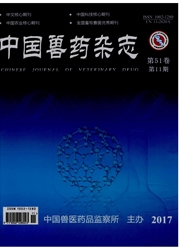

 中文摘要:
中文摘要:
为了研究哺乳期磺胺间甲氧嘧啶(SMM)暴露对仔鼠骨骼肌蛋白质代谢及mTOR信号通路的影响,以0、10、50、200mg/(kg·d)剂量对哺乳期ICR小鼠灌胃给药直至出生后21d;第22天断乳时剖杀部分仔鼠,采集腓肠肌,BCA法测定其腓肠肌总蛋白含量,氨基酸分析仪测定其游离氨基酸水平,RT—PCR法检测其mTOR信号通路关键基因表达水平;另一部分仔鼠以性别分笼喂养至出生后63d,并每周称重1次。与对照组比较,结果表明仔鼠体重无统计学差异(P〉0.05);中剂量组仔鼠腓肠肌谷氨酸(Glu),甘氨酸(Gly),丙氨酸(Ala),瓜氨酸(Cit),蛋氨酸(Met),组氨酸(His)和鹅肌肽(Ans)含量显著升高(P〈0.05);高剂量组的Cit和Ans含量也显著升高(P〈0.05),而低剂量组的Cit含量显著降低(P〈0.01);仔鼠腓肠肌Mtor,Pi3k3ca,Pi3k3cb,Aktl,Eif4ebpl和Rps6kbl等基因表达无统计学差异(P〉0.05);腓肠肌总蛋白含量无统计学差异(P〉0.05)。哺乳期SMM暴露对仔鼠骨骼肌氨基酸代谢有一定的改变作用;对mTOR信号通路并未产生显著影响,为临床上探讨生命早期SMM暴露是否引起代谢性疾病问题提供了毒理学风险评估依据。
 英文摘要:
英文摘要:
The aim of this study was to explore the effects of lactating mice exposed to sulfamonomethoxine (SMM) on skeletal muscle protein metabolism and the mTOR signaling pathway in offspring muscle. The lactating mice were gavaged with 0, 10, 50, 200 mg/(kg· d) SMM for 21 d. On postnatal day(PND) 22, some of theoffspring were sacrificed and the gastrocnemius muscles were collected. And then the other offspring were separated with gender, raised normally until PND 63, weighted once every week. The composition of free amino acids in muscle was analyzed by the automatic amino acid analyzer, the key gene expressions of mTOR pathwaywere quantitatively determined using real - time polymerase chain; Finally, the contents of total protein were determined by bicinchoninic acid method in muscle. Compared with controls, the exposure to SMM on body weight of the offspring made no significant difference during the experimental period ( P 〉 0.05 ). And at PND 22, the concentrations of Glu, Gly, Ala, Cit, Met, His and Ans were increased significantly in middle dose group (P 〈 0.05 ), the ones of Cit and Ans were increased significantly at the high dose (P 〈 0.05 ), but the one of Cit was notably decreased in the low dose group ( P 〈 0.01 ). The expressionsof Mtor, Pi3k3ca, Pi3k3cb, Aktl, Eif4ebpl and Rps6kbl were not c muscle were not changed in the treated profilingin hanged significantly ( P 〉 0.05 ). Moreover, the content of total protein in groups. Together, lactating exposure to SMM altered the free amino acid offspring skeletal muscle, but the mTOR signaling pathway was not obviouslyaffected, all of whichwill provide a scientific basis for toxiclogic risk assessment ofcausing metabolic problems when in early lifeexposure to SMM.
 同期刊论文项目
同期刊论文项目
 同项目期刊论文
同项目期刊论文
 期刊信息
期刊信息
